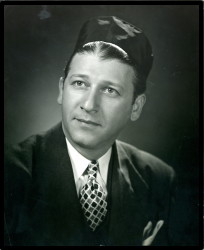From earliest times our High Holy Day synagogue chants and melodies have been the sounding board of the moods and emotions of the Jewish people. The MaHaRIL, Rabbi Jacob ben Moses Molin, in the early 15th Century, recognized this important aspect of the liturgy when he set certain standards and practices for the music in the synagogue and community. His works became the guiding light for all of Eastern European, Ashkenazic Jewry. He codified Jewish music in order to make it uniform for each synagogue and to categorize different musical modes for different daily, Sabbath and holiday settings throughout the year in order to match the particular mood to the particular day. This is especially true with regard to the High Holy Days.
For example, the opening of the Rosh Hashanah Maariv Service begins with a melody that has a majestic character. It serves as a prelude that creates the atmosphere of the day. From the very outset it proclaims that the kingdom of G-d is one of the major themes of the High Holy Day service. Early Chassidim actually called the first night of Rosh Hashanah, “Coronation Night.” The King on high has entered to sit on his throne. It is no wonder that Jews everywhere join together with this exultant theme.
Another place where the mood is evident is the next morning with the beginning of the Shacharit, the morning service, at which time we begin the service with the word, Hamelech, the King. This time, however, the mood is more somber and serious as the process of judging His children has begun. The Maharil popularized the practice that is traditional today. He began in a hushed, plaintive manner and gradually increased the volume heard by the congregation with awe and dread.
The Torah reading for the High Holy Days is also sung in a special mode unlike the rest of the year. According to the Maharil, this is done to emphasize the awesome character of the day so that the congregants might lend their ears to the reading and thus make amends for their faults. The sounding of the Shofar, whose purpose is to rouse Jews into seeking repentance, is also considered a momentous occasion in the synagogue service. The benedictions preceding them are recited in a special, almost royal, melody as one would hear from a series of trumpets heralding the entry of the King.
After the sounding of the Shofar, before the additional or Musaf service, the Cantor, known in Hebrew as the Chazzan or Shaliach Tzibbur, chants a deeply moving personal supplication, the Hineni. The chant does not have a fixed melody or any traditional motif and originally was sung silently by the Cantor. With the passing of time, he raised his voice at those words or phrases that had the power to arouse the emotions of the worshippers who quietly awaited the conclusion of the prayer. Although the Cantor today chants most if not all of the prayer out loud, there is still the tradition of increasing the dynamic at certain phrases.
The greatest and most exalted moment of the Rosh Hashanah service comes when the Ark is opened and the Un’sahne Tokef prayer begins. The text talks about how G-d judges the world on the fearful and solemn days of Rosh Hashanah and Yom Kippur. The prayer reaches its climax at the words Uteshuvah, Utefillah, Utzedaka Ma’avirin Et Ro’a Hagezerah, BUT REPENTANCE, PRAYER AND CHARITY WILL CANCEL THE STERN DECREE, with the congregation and the cantor crying out the phrase in unison. The congregation by this phrase calms itself somewhat from the unnatural fear that gripped it while reciting this stirring prayer.
Finally, as the service closes on the morning of Rosh Hashanah, the prayer Hayom Te’amtzenu (Strengthen us today) takes on a spirited and cheerful quality. Since this is the last prayer of the day, a happy tune is appropriate and demonstrates a lessening of the fear that prevailed for the Day of Judgment and will enable worshipers to return home with hope and confidence for a good year.
The Rosh Hashanah recordings included below are from October 6, 1967 at the Chicago Loop Synagogue. The compositions you will hear include my father's Hineni, V'chol Ma'aminim, and portions of the Malchuyot, Zichronot, and Shoferot.
| Hineni | |
| L'eil Orech Din | |
| B'rosh Hashanah | |
| Ki Keshimicha - Adom Yesodo | |
| V'chol Ma'aminim | |
| V'yehehtoyu Kol L'avdecha | |
| Umipnei Chatoeinu | |
| Heyei Im P'fiyos | |
| O'chilah L'eil | |
| Al Kein Nikover | |
| M'loch (Malchuyot) | |
| Atah Zocher | |
| Haven Yakir Li | |
| Zochreinu Bezikuron | |
| Atah Niglasa | |
| Tika Beshofar Gadol | |
| Areshet Sefatanu | |
| Sim Shalom |
